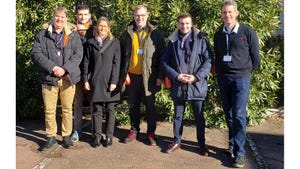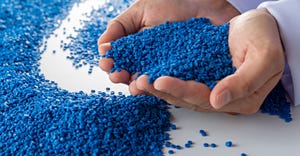Expecting good parts? Nervous or curious? Give your mold a sonogram!
August 12, 1998
Mold sonogram shows the thicknesses of liquid and solidified layers inside a mold over time. |
The Industrial Materials Institute (IMI) of the National Research Council of Canada is perfecting systems that use computerized ultrasonics technology for accurate, nonintrusive, and nondestructive measurement of the surface and interior of molding materials during the filling, packing/holding, and cooling phases of the injection molding cycle. IMI's systems use pulse-echo ultrasonic measurement techniques similar in principle to those used for an expectant mother's sonogram to listen through tool steel and see parts as they are being molded.
These pulse-echo signals can be used to verify CAE flow-analysis simulations or to control gas injection speed and gas pressure in gas-assist molding. Moreover, the signals could be used as feedback for an injection-to-ejection process controller that closes the loop between the material and the machine more effectively than ever before.
When ultrasonic waves meet the acoustic-resistance boundary between two different media-such as between the mold and the melt flow front, the air gap formed when a cooling part shrinks away from the cavity wall, between material and the gas channel, or between two coinjected materials-some of the energy is transmitted through the boundary. The rest of the energy is reflected back.
Therefore, pulse-echo measurements can be operated in two different modes. In the reflection mode, the signal is transmitted and received by the same ultrasonic transducer (UT). In the transmission mode, the signal is transmitted by one UT and received by another. The reflection mode is preferred in molding since only one half of the mold needs to be instrumented with a transducer.
No mold modifications are required for UT instrumentation. That is what's meant by ultrasonics being "nonintrusive." UTs can be attached anywhere outside the mold, using just an adhesive if need be. The UTs typically used at IMI are * inch in diameter, * inch long, and are available off the shelf from sensor suppliers, such as Panametrics and KB-Aerotech. They cost about $300 apiece.
A multiplexer is required for monitoring and managing the high-speed pulse-echo signals. A multiplexer capable of monitoring up to 48 channels costs less than $5000. IMI has written programs on top of commercially available software that processes the pulse-echo signal data in real time and displays the ultrasonic process profiles. It can run on a laptop.
Seeing a Part's Heart
IMI's system measures variations in the velocity and amplitude of ultrasonic waves when they meet acoustic resistance. Because it is what's called a "mechanical wave," an ultrasonic wave travels extremely quickly, in the tens-of-microseconds range. Data can be accurately gathered every 10 ms. Heat transfer measurement systems like infrared cameras also can "see" melt through a mold and see through the melt itself somewhat, but heat waves are slower than mechanical waves, down around 50 ms. Also, molding materials like plastics are mechanical materials with mechanical properties that can only be measured in real time by a mechanical wave. Wave readings from inside a shot have been found to relate to properties such as material density, temperature, residual stress, and elasticity.
With an ultrasonic process controller monitoring the flow front, a smoother transition from filling could be achieved for more precise high-speed/low-pressure molding. Flash could be eliminated, and mold life could be improved. Dynamic, energy-saving control over holding time could be achieved by monitoring the air gap development at the gate. By monitoring the air gap caused by the shrinkage of the parts in the mold, mold cooling could be optimized, as could packing pressure and cycle time in general. UTs measuring air gap formation have been found by IMI to be faster, more reliable, and more repeatable than those systems based on more conventional pressure transducers.
Instrumental to these projects at IMI is Cheng-Kuei Jen, senior research officer, who earned his Ph. D. in ultrasonic monitoring. Jen holds more than 10 patents and has authored more than 180 technical papers in ultrasonics. He has been involved in the field for some 20 years. He works with 22 experienced associates, including Ky T. Nguyen, an IMI research officer specializing in computer modeling. They have at hand a number of advanced technology resources, such as their well-equipped lab, which houses a 400-ton Husky equipped with a Cinpres gas-assist unit, a 150-ton Engel coinjection machine, and a variety of other primary and secondary equipment, control systems, and analytical instruments. They also make molds in-house.
IMI officials have begun preliminary negotiations with sensor suppliers and molding machinery manufacturers to bring its on-line ultrasonic monitoring technology to market. As part of the National Research Council of Canada, which is an organization funded by the government and the private sector, IMI is not allowed to sell the technology it develops. Rather it works to transfer technology to industry on a nonexclusive basis. IMI scientists say they are very optimistic this technology will be used and that it will be used soon.
You May Also Like


